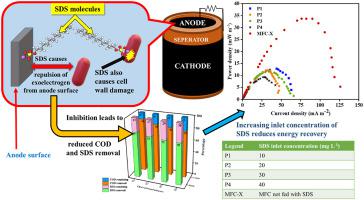当前位置:
X-MOL 学术
›
Int. Biodeterior. Biodegrad.
›
论文详情
Our official English website, www.x-mol.net, welcomes your
feedback! (Note: you will need to create a separate account there.)
Removal of sodium dodecyl sulphate from wastewater and its effect on anodic biofilm and performance of microbial fuel cell
International Biodeterioration & Biodegradation ( IF 4.1 ) Pub Date : 2021-01-01 , DOI: 10.1016/j.ibiod.2020.105108 Indrajit Chakraborty , Gourav Dhar Bhowmick , Dibyojyoty Nath , C.N. Khuman , B.K. Dubey , M.M. Ghangrekar
International Biodeterioration & Biodegradation ( IF 4.1 ) Pub Date : 2021-01-01 , DOI: 10.1016/j.ibiod.2020.105108 Indrajit Chakraborty , Gourav Dhar Bhowmick , Dibyojyoty Nath , C.N. Khuman , B.K. Dubey , M.M. Ghangrekar

|
Abstract This investigation demonstrates that sodium dodecyl sulphate (SDS) can be biodegraded efficaciously in MFC within a retention time of 12 h. The application of MFC for degradation of SDS and its corresponding effect on the power generation and organic matter removal capacity of MFC was first time quantified in this investigation. This investigation also illustrated the SDS induced microbial diversification of the anodic biofilm and correlates the same with the established SDS degradation pathway. Presence of microbial strains, such as Acinetobacter, Pseudomonas, Citrobacter, Treponema etc., capable of degrading complex and refractory organics was identified using the next-generation sequencing (NGS) analysis of the anodic biofilm. Compared to the identical control MFC, the power performance of MFC-SDS reduced by 66%. This was attributed to the inhibitory effect of SDS on the cell membrane as well as the biofilm growth. Furthermore, the chemical oxygen demand (COD) and SDS removal efficiencies exhibited that the microbes preferred L-cysteine over SDS as a substrate due to higher bioavailability of the former. In spite of the preferential choice of L-cysteine over SDS and the inhibitory effect of SDS over the formation of anodic biofilm, a constant SDS removal efficiency of 70% and above was achieved.
中文翻译:

废水中十二烷基硫酸钠的去除及其对阳极生物膜和微生物燃料电池性能的影响
摘要 本研究表明,十二烷基硫酸钠 (SDS) 在 MFC 中可在 12 小时的保留时间内有效生物降解。本研究首次量化了 MFC 降解 SDS 的应用及其对 MFC 发电和有机物去除能力的相应影响。该研究还说明了 SDS 诱导的阳极生物膜微生物多样化,并将其与已建立的 SDS 降解途径相关联。使用阳极生物膜的下一代测序 (NGS) 分析鉴定了微生物菌株的存在,例如不动杆菌属、假单胞菌属、柠檬酸杆菌属、密螺旋体等,能够降解复杂和难降解的有机物。与相同的对照 MFC 相比,MFC-SDS 的功率性能降低了 66%。这归因于SDS对细胞膜以及生物膜生长的抑制作用。此外,化学需氧量 (COD) 和 SDS 去除效率表明,由于前者的生物利用度更高,微生物更喜欢 L-半胱氨酸而不是 SDS 作为底物。尽管 L-半胱氨酸优先于 SDS 以及 SDS 对阳极生物膜形成的抑制作用,但仍实现了 70% 及以上的恒定 SDS 去除效率。
更新日期:2021-01-01
中文翻译:

废水中十二烷基硫酸钠的去除及其对阳极生物膜和微生物燃料电池性能的影响
摘要 本研究表明,十二烷基硫酸钠 (SDS) 在 MFC 中可在 12 小时的保留时间内有效生物降解。本研究首次量化了 MFC 降解 SDS 的应用及其对 MFC 发电和有机物去除能力的相应影响。该研究还说明了 SDS 诱导的阳极生物膜微生物多样化,并将其与已建立的 SDS 降解途径相关联。使用阳极生物膜的下一代测序 (NGS) 分析鉴定了微生物菌株的存在,例如不动杆菌属、假单胞菌属、柠檬酸杆菌属、密螺旋体等,能够降解复杂和难降解的有机物。与相同的对照 MFC 相比,MFC-SDS 的功率性能降低了 66%。这归因于SDS对细胞膜以及生物膜生长的抑制作用。此外,化学需氧量 (COD) 和 SDS 去除效率表明,由于前者的生物利用度更高,微生物更喜欢 L-半胱氨酸而不是 SDS 作为底物。尽管 L-半胱氨酸优先于 SDS 以及 SDS 对阳极生物膜形成的抑制作用,但仍实现了 70% 及以上的恒定 SDS 去除效率。











































 京公网安备 11010802027423号
京公网安备 11010802027423号